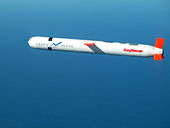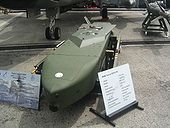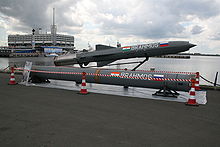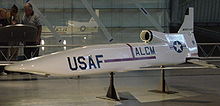- Cruise missile
-
A cruise missile is a guided missile that carries an explosive payload and is propelled, usually by a jet engine, towards a land-based or sea-based target. Cruise missiles are designed to deliver a large warhead over long distances with high accuracy. Modern cruise missiles can travel at supersonic or high subsonic speeds, are self-navigating, and can fly on a non-ballistic, extremely low altitude trajectory. They are distinct from unmanned aerial vehicles (UAV) in that they are used only as weapons and not for reconnaissance. In a cruise missile, the warhead is integrated into the vehicle and the vehicle is always sacrificed in the mission.
Cruise missile designs fundamentally derive from the German V-1 of World War II. Advances in transistor and computer technology allowed self-correcting avionic and aeronautical designs that allowed missiles to be guided in flight, as opposed to only at launch. These advances developed into guided missiles and guided bombs, and later into the modern cruise missile. As of 2010, India's Brahmos is the world's fastest cruise missile in operation. [1]
In 2011, it was estimated that a single Tomahawk cruise missile costs £500,000 (US$830,000).[2]
Contents
History
The idea of an "aerial torpedo" was shown in the British 1909 film The Airship Destroyer, where flying torpedoes controlled by wireless are used to bring down airships bombing London.[3]
In 1916, Lawrence Sperry patented and built an "aerial torpedo", a small biplane carrying a TNT charge, a Sperry autopilot and a barometric altitude control. Inspired by these experiments, the US Army developed a similar flying bomb called the Kettering Bug. In the period between the World Wars the United Kingdom developed the Larynx (Long Range Gun with Lynx Engine) which underwent a few flight tests in the 1920s.[4] In the Soviet Union, Sergey Korolev headed the GIRD-06 cruise missile project from 1932–1939, which used a rocket-powered boost-glide design.[citation needed] The 06/III (RP-216) and 06/IV (RP-212) contained gyroscopic guidance systems.
Germany first deployed cruise style missiles, during World War II. The V-1, often referred to as flying bomb, contained a gyroscopic guidance system and was propelled by a simple pulse-jet engine, the sound of which gave it the nickname of "buzz bomb". Accuracy was sufficient only for use against very large targets (the general area of a city), while the range of 250 km was significantly lower than that of a bomber carrying the same payload. The main advantages were speed (while not sufficient to outperform contemporary interceptors) and expendability. The production cost of a V-1 was only a small fraction of that of a V-2 supersonic ballistic missile, carrying a similar-sized warhead. Unlike the V-2, however, the V-1 required stationary launch ramps which were susceptible to bombardment. Nazi Germany, in 1943, also developed the Mistel program which can be seen as a rudimentary air-launched cruise missile, where a piloted fighter-type aircraft was mounted atop an unpiloted bomber-sized aircraft that was packed with explosives to be released while approaching the target.
Immediately after the war the United States Air Force had 21 different guided missile projects including would-be cruise missiles. All were cancelled by 1948 except four: the Air Material Command BANSHEE, the SM-62 Snark, the SM-64 Navaho, and the MGM-1 Matador. The BANSHEE design was similar to Operation Aphrodite; like Aphrodite it failed, and was canceled in April 1949.[5]
During the Cold War period both the United States and the Soviet Union experimented further with the concept, deploying early cruise missiles from land, submarines and aircraft. The main outcome of the US Navy submarine missile project was the SSM-N-8 Regulus missile, based upon the V-1.
The US Air Force's first operational surface-to-surface missile was the winged, mobile, nuclear-capable MGM-1 Matador, also similar in concept to the V-1. Deployment overseas began in 1954, first to West Germany and later to the Republic of China (Taiwan) and South Korea. On November 7, 1956 U. S. Air Force Matador units in West Germany, whose missiles were capable of striking targets in the Warsaw Pact, deployed from their fixed day-to-day sites to unannounced dispersed launch locations. This alert was in response to the crisis posed by the Soviet attack on Hungary which suppressed the 1956 Hungarian Revolution.
Between 1957 and 1961 the United States followed an ambitious and well-funded program to develop a nuclear-powered cruise missile, Project Pluto. It was designed to fly below the enemy's radar at speeds above Mach 3 and carry a number of hydrogen bombs that it would drop on its path over enemy territory. Although the concept was proven sound and the 500 megawatt engine finished a successful test run in 1961, no airworthy device was ever completed. The project was finally abandoned in favor of ICBM development.
While ballistic missiles were the preferred weapons for land targets, heavy nuclear and conventional tipped cruise missiles were seen by the USSR as a primary weapon to destroy US naval carrier battle groups. Large submarines (for example, Echo and Oscar classes) were developed to carry these weapons and shadow US battle groups at sea, and large bombers (for example, Backfire, Bear, and Blackjack models) were equipped with the weapons in their air-launched cruise missile (ALCM) configuration.
General design
Cruise missiles generally consist of a guidance system, payload, and propulsion system, housed in an airframe with small wings and empennage for flight control. Payloads usually consist of a conventional warhead or a nuclear warhead. Cruise missiles tend to be propelled by a jet engine, turbofan engines being preferred due to their greater efficiency at low altitude and sub-sonic speed.
Guidance systems
Guidance systems also vary greatly. Low-cost systems use a radar altimeter, barometric altimeter and clock to navigate a digital strip map. More advanced systems use inertial guidance, satellite navigation and terrain contour matching (TERCOM). Use of an automatic target recognition (ATR) algorithm/device in the guidance system increases accuracy of the missile. The Standoff Land Attack Missile features an ATR unit from General Electric.
Categories
Cruise missiles can be categorized by size, speed (subsonic or supersonic), and range, and whether launched from land, air, surface ship, or submarine. Often versions of the same missile are produced for different launch platforms; sometimes air- and submarine-launched versions are a little lighter and smaller than land- and ship-launched versions.
Guidance systems can vary across missiles. Some missiles can be fitted with any of a variety of navigation systems (Inertial navigation, TERCOM, or satellite navigation). Larger cruise missiles can carry either a conventional or a nuclear warhead, while smaller ones carry only conventional warheads.
Hypersonic
A hypersonic cruise missile would travel at least 5 times the speed of sound. These are still in the developmental stage. The US Arclight Program is investigating a very long range weapon incorporating a hypersonic glider. Examples:
- BrahMos II
 India/
India/ Russia The joint Russia/India venture is in the testing phase.
Russia The joint Russia/India venture is in the testing phase.
Supersonic
These missiles travel faster than the speed of sound, usually using ramjet engines. The range is typically 100–500 km, but can be greater. Guidance systems vary.
Examples
- BrahMos
 India /
India /  Russia (currently the fastest cruise missile in operation anywhere in the world)
Russia (currently the fastest cruise missile in operation anywhere in the world) - C-101
 China
China - C-301
 China
China - C-803
 China supersonic terminal stage only
China supersonic terminal stage only - C-805
 China
China - KD-88
 China
China
- P-800 Oniks
 Soviet Union/
Soviet Union/  Russia
Russia - Kh-31
 Russia
Russia - 3M-54 Klub
 Russia "Sizzler" variant is capable of supersonic in terminal stage.
Russia "Sizzler" variant is capable of supersonic in terminal stage. - Air-Sol Moyenne Portée
 France - supersonic stand-off nuclear missile
France - supersonic stand-off nuclear missile - P-500 Bazalt
 Soviet Union/
Soviet Union/  Russia
Russia - P-700 Granit
 Soviet Union/
Soviet Union/  Russia
Russia - P-270 Moskit
 Soviet Union/
Soviet Union/  Russia
Russia - YJ-91
 China
China
Long-range subsonic
The US, USSR, UK, China, Pakistan and India have developed several long-range subsonic cruise missiles. These missiles have a range of over 1,000 kilometres (620 mi) and fly at about 800 kilometres per hour (500 mph).[citation needed] They typically have a launch weight of about 1,500 kilograms (3,300 lb)[citation needed] and can carry either a conventional or a nuclear warhead. Earlier versions of these missiles used inertial navigation; later versions use much more accurate TERCOM and DSMAC systems. Most recent versions can use satellite navigation.
Examples:
- AGM-86B
 United States
United States - AGM-129 ACM
 United States
United States - BGM-109 Tomahawk
 United States/
United States/ United Kingdom
United Kingdom - Nirbhay
 India (under development)
India (under development) - CJ-10
 People's Republic of China
People's Republic of China - DH-10
 People's Republic of China
People's Republic of China - Babur II
 Pakistan(in development)
Pakistan(in development) - Hyunmoo IIIC
 South Korea[6]
South Korea[6] - KH-55
 Russia
Russia
Medium-range subsonic
These missiles are about the same size and weight and fly at similar speeds to the above category, but the range is (officially)[citation needed] less than 1,000 km. Guidance systems vary.
Examples:
- AGM-158 JASSM
 United States (in development)
United States (in development) - Babur
 Pakistan
Pakistan - KD-63
 China
China - Ra'ad ALCM
 Pakistan
Pakistan - SOM (missile) [7][8]
 Turkey
Turkey - Storm Shadow/SCALP
 United Kingdom/
United Kingdom/ France/
France/ Italy
Italy - Taurus KEPD 350
 Germany/
Germany/ Sweden
Sweden
Short-range subsonic
These are subsonic missiles which weigh around 500 kilograms (1,102 lb) and have a range of 300 km (190 mi).[citation needed]
Examples:
- AVMT-300
 Brazil
Brazil - C-801
 China
China - C-802
 China
China - C-602
 China
China - Delilah missile
 Israel
Israel - Kh-35
 Russia
Russia - Nasr-1
 Iran
Iran - Naval Strike Missile
 Norway
Norway - RBS-15
 Sweden
Sweden - Silkworm
 China
China - Type 80 Air-to-Ship Missile
 Japan
Japan - Type 88 Surface-to-Ship Missile
 Japan
Japan - Type 90 Ship-to-Ship Missile
 Japan
Japan - Type 91 Air-to-Ship Missile
 Japan
Japan - Type 93 Air-to-Ship Missile
 Japan
Japan
Deployment
The most common mission for cruise missiles is to attack relatively high-value targets such as ships, command bunkers, bridges and dams[citation needed]. Modern guidance systems permit precise attacks.
(As of 2001) the BGM-109 Tomahawk missile model has become a significant part of the US naval arsenal. It gives ships and submarines an extremely accurate, long-range, conventional land attack weapon. Each costs about $600,000 USD.[9] The US Air Force deploys an air launched cruise missile, the AGM-86. It can be launched from bombers like the B-52 Stratofortress. Both the Tomahawk and the AGM-86 were used extensively during Operation Desert Storm.
Both Tomahawk (as BGM-109) and ALCM (AGM-86) were competing designs for the US.F. ALCM nuclear tipped cruise missile to be carried by the B-52 heavy bomber.[citation needed] The US.F adopted the AGM-86 for its bomber fleet while AGM-109 was adapted to launch from trucks and ships and adopted by the US.F and Navy. The truck-launched versions, and also the Pershing II and SS-20 Intermediate Range Ballistic Missiles, were later destroyed under the bilateral INF (Intermediate Range Nuclear Forces) treaty with the USS.R.
The British Royal Navy (RN) also operates cruise missiles, specifically the US-made Tomahawk, used by the RN's nuclear submarine fleet. Conventional warhead versions were first fired in combat by the RN in 1999, during the Kosovo War. The Royal Air Force uses the Storm Shadow cruise missile on its Tornado GR4 aircraft. It is also used by France, where it is known as SCALP EG, and carried by the Armée de l'Air's Mirage 2000 and Rafale aircraft.
India and Russia have jointly developed the supersonic cruise missile BrahMos. There are three versions of the Brahmos: ship/land-launched, air-launched and sub-launched. The ship/land-launched version were operational as of late 2007. The Brahmos has the capability to attack targets on land. Russia also continues to operate other cruise missiles: the SS-N-12 Sandbox, SS-N-19 Shipwreck, SS-N-22 Sunburn and SS-N-25 Switchblade. Germany and Spain operate the Taurus missile while Pakistan has developed its own cruise missile somewhat similar to Tomahawk cruise missile, named the Babur missile. Both the People's Republic of China and the Republic of China (Taiwan) have designed several cruise missile variants, such as the well-known C-802, some of which are capable of carrying biological, chemical, nuclear, and conventional warheads.
Nuclear warhead versions
The US has 460 AGM-129 Advanced Cruise Missiles (ACMs) with a W80 nuclear warhead (5 kt or 150 kt selectable yield) for B-52 Stratofortress (B-52H) external carriage. Also there are approximately 350 sea-launched cruise missiles with the same nuclear warhead. The range of the missile is 3000 km. These missiles have been "mothballed" and placed in storage.
The SSM-N-8 Regulus was also designed for a nuclear warhead.
See also:
- The United States and weapons of mass destruction
- Intermediate-Range Nuclear Forces Treaty
- Woensdrecht
Russia has Kh-55SM cruise missiles, with similar to US AGM-129 range of 3000 km, but are able to carry more powerful warhead of 200 kt. They are equipped with a TERCOM system which allows them to cruise at an altitude lower than 110 meters at subsonic speeds while obtaining a CEP accuracy of 15 meters with an Inertial navigation system. They are air-launched from either Tupolev Tu-95s, Tupolev Tu-22Ms, or Tupolev Tu-160s, each able to carry 16 for the Tu-95, 12 for the Tu-160, and 4 for the Tu-22M. A Stealth version of the missile, the Kh-101 is in development. It has similar qualities as the Kh-55, except that its range has been extended to 5,000 km, equipped with a 1,000 kg conventional warhead, and has stealth features which reduces its probability of intercept.[10]
Efficiency in modern warfare
Currently cruise missiles are among the most expensive of single-use weapons, up to several million dollars apiece. One consequence of this is that its users face difficult choices in targeting, to avoid expending the missiles on targets of low value. For instance during Operation Enduring Freedom the United States attacked targets of very low monetary value with cruise missiles, which led many to question the efficiency of the weapon. However, proponents of the cruise missile counter that the same argument applies to other types of UAVs: they are cheaper than human pilots when total training and infrastructure costs are taken into account, not to mention the risk of loss of personnel. As demonstrated in the ongoing Operation Odyssey Dawn and prior conflicts, cruise missiles are much more difficult to detect and intercept than other aerial assets, making them particularly suited to attacks against static air defense systems.
See also
- List of missiles by country
- Low Cost Miniature Cruise Missile
- Surface-to-surface missile
- Weapons of mass destruction
- List of weapons
- List of missiles
- List of missiles by nation
- List of rocket planes
- Intercontinental ballistic missile
- Expendable launch system
- NATO reporting name (has lists of various Soviet missiles)
References
- ^ http://www.brahmos.com/newscenter.php?newsid=122
- ^ http://www.bbc.co.uk/news/uk-12806709 According to Prof Malcolm Charmers of defence think-tank the Royal United Services Institute
- ^ http://www.ctie.monash.edu.au/hargrave/rpav_britain.html
- ^ British Aerial Torpedoes
- ^ The Evolution of the Cruise Missile by Werrell, Kenneth P. see PDF page 92
- ^ S.Korea develops long-range cruise missile: report
- ^ http://www.hurriyet.com.tr/gundem/17954640.asp?gid=381
- ^ http://www.kirpihaber.com/teknoloji-bilim/yerli-seyir-fuzesi-180-kilometreden-hedefinin-vuracak.htm
- ^ The US Navy - Fact File
- ^ http://www.fas.org/nuke/guide/russia/bomber/kh-101.htm
External links
- The Evolution of the Cruise Missile by Werrell, Kenneth P.
- The Cruise Missile: Precursors and Problems by Werrell, Kenneth P.
- An introduction to cruise missiles – From the website of the Federation of American Scientists (FAS)
- Feasibility of Third World Advanced Ballistic & Cruise Missile Threat NDIA 155 slide presentation from 1999
- The DIY cruise missile
- The W80 Warhead
- Cruise Missile Fundamentals
- Tomahawk Variants
- Bypassing the NMD: China and the Cruise Missile Proliferation Problem (Kh-55)
- Video of cruise missile formation over Iraq
- A commercial terrain matching image-based navigation system (with video)
Types of missile By platform - Air-to-air missile (AAM)
- Air-to-surface missile (ASM)
- Surface-to-air missile (SAM)
- Surface-to-surface missile (SSM)
- Ballistic missile
- Intercontinental ballistic missile (ICBM)
- Submarine-launched ballistic missile (SLBM)
- Anti-ballistic missile (ABM)
- Intermediate-range ballistic missile (IRBM)
- Cruise missile
- Anti-ship missile (AShM)
- Anti-submarine missile
- Anti-tank missile (ATGM)
- Anti-satellite weapon (ASAT)
- Air-launched ballistic missile
- Anti-ship ballistic missile (ASBM)
By guidance Lists - List of missiles
- List of missiles by country
- List of military rockets
Lists relating to aviation General Aircraft (manufacturers) · Aircraft engines (manufacturers) · Airlines (defunct) · Airports · Civil authorities · Museums · Registration prefixes · Rotorcraft (manufacturers) · TimelineMilitary Accidents/incidents Records Categories:- Cruise missiles
- Missile types
- BrahMos II
Wikimedia Foundation. 2010.








